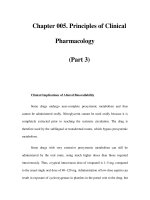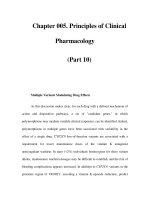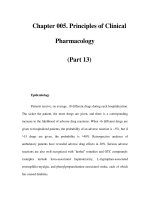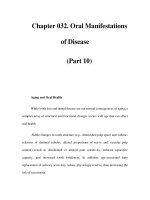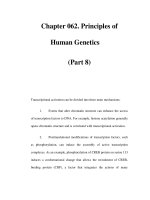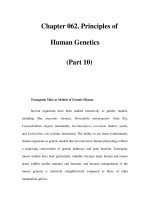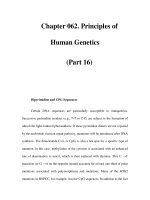ABC OF CLINICAL GENETICS - PART 10 docx
Bạn đang xem bản rút gọn của tài liệu. Xem và tải ngay bản đầy đủ của tài liệu tại đây (136.39 KB, 12 trang )
Glossary
109
Embryo biopsy Method for preimplantation
diagnosis of genetic disorders
used in conjunction with in vitro
fertilisation.
Empirical risk Risk of recurrence for multifactorial
or polygenic disorders based on
family studies.
Epigenetic Heritable mechanisms not due to
changes in DNA sequence, for
example methylation patterns.
Eugenics The use of genetic measures to
alter the genetic characteristics
of a population.
Euploid Presence of one or more complete
sets of chromosomes with no
single chromosomes extra or
missing.
Exon Region of a gene transcribed into
messenger RNA.
Fetoscopy Endoscopic procedure permitting
direct visual examination of the
fetus.
Fluorescence in situ Use of fluorescent nucleic acid
hybridisation (FISH) probes to detect presence
or absence of specific sequences
in chromosome preparations
or tissue sections.
Frameshift mutation Mutation that alters the normal
reading frame of mRNA by
adding or deleting a number of
bases that is not a multiple of
three.
Gain of function Mutation that generates novel
mutation function of a gene product not
just the loss of normal function.
Gamete Egg or sperm.
Gene The unit of inheritance, composed
of DNA.
Genetic Process by which information on
counselling genetic disorders is given to
a family.
Genome Total DNA carried by a gamete.
Genotype Genetic constitution of an
individual person.
Germline The cell lineage resulting in
formation of eggs or sperm.
Germline (gonadal) Presence of a mutation in some but
mosaicism not all germline somatic cells.
Haploid Normal state of gametes, containing
one set of chromosomes (n).
Haplotype Particular set of alleles at linked
loci on a single chromosome
that are inherited together.
Hemizygote Person having only one copy of a
gene in diploid cells (males are
hemizygous for most X linked
genes).
Heritability The contribution of genetic as
opposed to environmental factors
to phenotypic variance.
Heteroplasmy Presence (usually within single
cells) of different mitochrondrial
DNA variants in an individual.
Heterozygote Person possessing different alleles at
a particular locus on homologous
chromosomes.
Holandric Pattern of inheritance of genes on
the Y chromosome.
Homologous Chromosomes that pair at meiosis
chromosomes and contain the same set of gene
loci.
Homoplasmy Presence of identical copies of
mitochondrial DNA in the cells of
an individual.
Homozygote Person having two identical alleles
at a particular locus on
homologous chromosomes.
Hybridisation Process by which single strands
of DNA or RNA with homologous
sequences bind together.
Imprinting Differential expression of a gene
dependent on parent of origin.
In-situ Hybridisation of a labelled nucleic
hybridization acid probe directly to DNA
or RNA – frequently applied to
chromosome preparations or
tissue sections.
Interphase The stage of the nucleus between
cell divisions.
Intron Region of a gene transcribed into
messenger RNA but spliced out
before translation into protein
product.
Isochromosome Abnormal chromosome composed
of two identical arms (p or q).
Karyotype Description of the chromosomes
present in somatic cells.
Kilobase (kb) 1000 base pairs (bp) of DNA.
Linkage Term describing genes or DNA
sequences situated close
together on the same
chromosome that tend to be
inherited together.
Linkage disequilibrium See allelic association.
Locus Site of a specific gene or DNA
sequence on a chromosome.
Lyonisation Process of X chromosome
inactivation in cells with more
than one X chromosome.
Marker General term for a biochemical or
DNA polymorphism occurring
close to a gene, used in gene
mapping.
Meiosis Cell division during gametogenesis
resulting in haploid gametes.
Mendelian disorder Inherited disorder due to a defect
in a single gene.
Metaphase Stage of cell division when
chromosomes are contracted and
become visible using light
microscopy.
Microdeletion Loss of a very small amount of
genetic material from a
chromosome, not visible with
conventional microscopy.
Microsatellite Variable run of tandem repeats
of a simple DNA sequence widely
used for gene mapping in the
1990s.
Mismatch repair Natural enzymatic process that
corrects mis-paired nucleotides
in a DNA duplex.
acg-gls 11/20/01 8:06 PM Page 109
ABC of Clinical Genetics
110
Mis-sense mutation Nucleotide substitution that results
in an amino acid change.
Mitochondria Cytoplasmic bodies containing
mitochondrial DNA and enzymes
concerned with energy production.
Mitochondrial Exclusively maternal inheritance of
inheritance mitochondrial DNA.
Mitosis Cell division occurring in somatic
cells resulting in diploid daughter
cells.
Modifier gene Gene whose expression influences
the phenotype resulting from
mutation at another locus.
Monogenic Inheritance controlled by single
(unifactorial) gene pair
Monosomy Loss of one of a pair of homologous
chromosomes.
Monozygotic twins Twins derived from a single
fertilised egg.
Mosaicism Presence in a person of two
different cell lines derived from
a single zygote.
Multifactorial disorder Disorder caused by interaction of
more than one gene plus the
effect of environment.
Multiple alleles Existence of more than two alleles
at a particular locus.
Mutation Alteration to the normal sequence
of nucleotides in a gene.
Nondisjunction Failure of separation of paired
chromosomes during cell
division.
Obligate carrier Family member who must be a
heterozygous gene carrier,
determined from the mode of
inheritance and the pattern of
affected relatives within the family.
Oncogene Gene involved in control of cell
proliferation that can transform
a normal cell into a tumour cell
when overactive.
Penetrance The frequency with which a
genotype manifests itself in a
given phenotype.
Phenotype Physical or biochemical
characteristics of a person
reflecting genetic constitution
and environmental influence.
Point mutation Substitution, insertion or deletion
of a single nucleotide in a gene.
Polygenic disorder Disorder caused by inheritance of
several/many susceptibility genes,
each with a small effect.
Polymerase Method of amplifying
chain reaction (PCR) specific DNA sequences by
repeated cycles of DNA synthesis.
Polymorphism Genetic characteristic with more
than one common form in a
population.
Polyploid Chromosome numbers representing
multiples of the haploid set
greater than diploid,
for example, 3n.
Polysome Group of ribosomes associated with
a particular messenger RNA
molecule.
Post-translational Alterations to protein structure after
modification synthesis.
Premutation A change in DNA that produces no
clinical effect, but predisposes to
the generation of a pathological
mutation.
Proband Index case through whom a family
is identified.
Probe Labelled DNA or RNA fragment
used to detect complementary
sequences in DNA or RNA
samples.
Promoter Combination of short DNA
sequences that bind RNA
polymerase to initiate
transcription of a gene.
Pseudogene Functionless copy of a known gene.
Purine Nitrogenous base: adenine or
guanine.
Pyrimidine Nitrogenous base: cytosine,
thymine or uracil.
Recessive Trait expressed in people who are
homozygous or hemizygous for a
particular gene, but not in those
who are heterozygous for the
gene.
Recombination Crossing over between homologous
chromosomes at meiosis which
separates linked loci.
Restriction endonuclease Enzyme that cleaves double
stranded DNA at a specific
sequence.
Restriction fragment Variation in size of DNA
length polymorphism fragments produced by
(RFLP) restriction endonueclease
digestion due to variation in
DNA sequence at the
enzyme recognition site.
Reverse transcriptase Enzyme catalysing the synthesis of
complementary DNA from
messenger RNA.
RNA Ribonucleic acid, produced by
transcription of DNA.
Segregation Separation of alleles during meiosis
so that each gamete contains only
one member of each pair of
alleles.
Sense strand DNA strand complementary to the
antisense (template) strand,
reflecting the transcribed RNA
sequence and quoted as the gene
sequence.
Sequence tagged Any unique sequence of DNA for
sites (STS) which a specific PCR assay has
been designed, enabling rapid
detection of the presence or
absence of this sequence in any
DNA sample.
Sibship Group of brothers and sisters.
Single nucleotide Any polymorphic variation at a
polymorphism (SNP) single nucleotide position, used
for large-scale automated scoring
of DNA samples.
Single stranded Commonly used method to screen
conformation for point mutations in genes.
polymorphism (SSCP)
acg-gls 11/20/01 8:06 PM Page 110
Glossary
111
Somatic Involving body cells rather than
germline cells.
Southern blotting Process of transferring DNA
fragments from agarose gel onto
nitrocellulose filter or nylon
membrane.
Splicing Removal of introns and joining of
exons in messenger RNA.
Syndrome A combination of clinical features
forming a recognisable entity.
Telomere Terminal region of the
chromosome arms.
Teratogen An agent that may damage a
developing embryo.
Trait Recognisable phenotype owing to a
genetic character.
Transcription Production of messenger RNA
from DNA sequence in gene.
Translation Production of protein from
messenger RNA sequence.
Translocation Transfer of chromosomal material
between two non-homologous
chromosomes.
Trinucleotide repeat A repeated sequence of three
nucleotides that becomes
expanded and unstable in a
group of genetic disorders.
Triploid Cells containing three haploid sets
of chromosomes (3n).
Trisomy Cells containing three copies of a
particular chromosome (2n ϩ1).
Tumour supressor Gene that functions to inhibit or
gene (TS) control cell division. Inactivating
mutations in TS genes occur in
tumours.
Unifactorial Inheritance controlled by single
(monogenic) gene pair.
Uniparental disomy The inheritance of both copies of a
particular chromosome from one
parent and none from the other
parent.
Uniparental Inheritance of both chromosomes
heterodisomy from a particular homologous pair
in the parent.
Uniparental isodisomy Inheritance of two copies of the
same chromosome from a
particular homologous pair
in the parent.
X inactivation See lyonisation.
Zygote The fertilised egg.
acg-gls 11/20/01 8:06 PM Page 111
112
Introductory and undergraduate books
Bonthron D, Fitzpatrick D, Porteous M, Trainer A. Clinical genetics:
a case based approach. London: Saunders, 1998.
Connor JM, Ferguson-Smith MA. Essential medical genetics. Oxford:
Blackwell, 1997.
Gelehrter TD, Collins FS, Ginsburg D. Principles of medical genetics.
Baltimore: Williams and Wilkins, 1998.
Mueller RF, Young ID. Emery’s Elements of medical genetics.
Edinburgh: Churchill Livingstone, 1998
Read A. Medical genetics: an illustrated outline. London: Gower
Medical, 1989.
Thompson M, McInnes J. Genetics in medicine. Philadelphia:
Saunders, 1998.
Trent RJ. Molecular medicine: an introductory text. Edinburgh:
Churchill Livingstone, 1997.
Short texts
Harper PS. Practical genetic counselling. Oxford: Butterworth
Heinemann, 1998.
Weatherall, DJ. The new genetics and clinical practice. Oxford: Oxford
University Press, 1991.
Young ID. Introduction to risk calculation in genetic counselling. Oxford:
Oxford University Press, 1991.
King R, Stansfield WD. A dictionary of genetics. Oxford: Oxford
University Press, 1996.
Snustaad DP, Simmonds MJ. Principles of genetics. New York: Wiley,
1997.
Day INM, Humphries SE (eds). Genetics of common diseases. Oxford:
Bios, 1997.
Ostrer H. Non-mendelian inheritance in humans. Oxford: Oxford
University Press, 1998.
Reference texts
Rimoin DL, Connor JM, Pyeritz RE, Emery AEH (eds). Emery and
Rimoin’s Principles and practice of medical genetics. Edinburgh:
Churchill Livingstone, 2001.
McKusick VA. Mendelian inheritance in man. Catalogs of Human
Genes and Genetic Disorders 12th edn. Baltimore: Johns Hopkins
Press, 1998. (Also available on line).
Vogel F, Motulsky AG. Human genetics, problems and approaches.
Berlin: Springer, 1996.
Gorlin RJ, Cohen MM, Hennekham RCM. Syndromes of the head and
neck. Oxford: Oxford University Press, 2001.
Scriver CR, Beaudet AL, Sly WS, Walle D (eds). Metabolic basis of
inherited disease. New York: McGraw-Hill, 1996.
King RA, Rotter J, Motulsky AG (eds). The genetics of common
disorders. Oxford: Oxford University Press, 1992.
Khoury MJ, Burke W, Thomson E (eds). Genetics and public health in
the 21st Century. Oxford: Oxford University Press, 2000.
Specific organ systems
Baraitser M. The genetics of neurological disorders. Oxford: Oxford
University Press, 1997.
Pulst S-M (ed). Neurogenetics. Oxford: Oxford University Press, 2000.
Emery AEH. (ed). Diagnostic criteria for neuromuscular disorders.
Oxford: Oxford University Press, 1997.
Emery AEH. (ed). Neuromuscular disorders: clinical and molecular
genetics. New York: Wiley, 1998.
Hagerman RJ, Cronister A (eds). Fragile X syndrome: diagnosis,
treatment and research. Baltimore: Johns Hopkins, 1996.
Plomin R, Defries JC, McClearn GE, Rutter M. Behavioural genetics.
New York: Freeman, 1997.
Wynne-Davies K, Hall CM, Apley AG. Atlas of skeletal dysplasias.
Edinburgh: Churchill Livingstone, 1985.
Sybert VP. Genetic skin disorders. New York: Oxford University Press,
1997.
Moss C, Savin J. Dermatology and the new genetics. Oxford: Blackwell,
1995.
Traboulski EI. Genetic diseases and the eye. Oxford: Oxford University
Press, 1998.
Taylor D (ed). Pediatric ophthalmology. Oxford: Blackwell Scientific
Publications, 1997.
Black GCM. Genetics for ophthalmologists. London: ReMEDICA, 2001.
Gorlin RJ, Toriello HV, Cohen MM. Hereditary hearing loss and its
syndromes. New York: Oxford University Press, 1995.
Cooper DN, Krawczak M. Venous thrombosis: from genes to clinical
medicine. Oxford: Bios Scientific Publishers, 1997.
Tuddenham EGD, Cooper DN. The molecular genetics of haemostasis
and its inherited disorders. Oxford: Oxford University Press, 1994.
Cancer genetics
Mitelman P. Catalog of chromosome aberrations in cancer. New York:
Wiley, 1998. (also available on CD)
Vogelstein B, Kinzler KW. The genetic basis of human cancer. New
York: McGraw-Hill, 1998.
Hodgson SV, Maher ER. A practical guide to human cancer genetics.
Cambridge: Cambridge University Press, 1999.
Lalloo FI. Genetics for oncologists. London: ReMEDICA, 2001.
Birth defects and dysmorphology
Aase JM. Diagnositic dysmorphology. New York: Plenum Medical, 1990.
Cohen MM. The child with multiple birth defects. New York: Oxford
University Press, 1997.
Jones KL. Smith’s recognisable patterns of human malformation.
Philadelphia: Saunders, 1988.
Baraitser M, Winter R. A colour atlas of clinical genetics. London:
Wolfe, 1988.
Stevenson RE, Hall JG, Goodman RM, (eds). Human malformations
and related anomalies. New York, Oxford: Oxford University Press,
1993.
Donnai D, Winter RM, (eds). Congenital malformation syndromes.
London: Chapman & Hall, 1995.
Winter RM, Knowles SAS, Bieber FR, Baraitser M. The malformed
fetus and stillbirth. A diagnostic approach. Chichester: Wiley, 1988.
Graham JM. Smith’s recognisable patterns of deformation. Philadelphia:
Saunders, 1998.
Wiedemann H-R, Kunze J. Clinical Syndromes. St. Louis: Mosby, 1997.
Hall JG, Froster-Iskenius VG, Allanson JE. Handbook of normal
physical measurements. Oxford: Oxford University Press, 1989.
Prenatal diagnosis and screening
Abramsky L, Chapple J (eds). Prenatal diagnosis. The human side.
London: Chapman & Hall, 1994.
Milunsky A. Genetic disorders and the fetus. Baltimore: Johns Hopkins,
1998.
Simpson JL, Golbus MS. Genetics in obstetrics and gynaecology.
Philadelphia: Saunders, 1998.
Wald N, Leck I (eds). Antenatal and neonatal screening. Oxford:
Oxford University Press, 2000.
Embryology and teratogenesis
Wolpert L, Beddington R, Brockes J, Jessel T, Lawrence P,
Meyerowitz E. Principles of development. Oxford: Current Biology
Ltd & Oxford University Press, 1998.
Moore KL, Persaud TVN. The developing human. Clinically orientated
embryology. Philadelphia: Saunders, 1998.
Shepard TH. Catalog of teratogenic agents. Baltimore: Johns Hopkins,
1998. (also available on CD).
Cytogenetics and chromosomal disorders
Rooney D, Czepulkowski B (eds). Human cytogenetics: constitutional
analysis. Oxford: Oxford University Press, 2001.
Schinzel A. Catalogue of unbalanced chromosome aberrations in man.
Berlin: De Gruyter, 1984. (also available on CD).
De Grouchy J, Turleau C. Clinical atlas of human chromosomes. New
York: Wiley, 1982. (also available on CD).
Gardner RJM, Sutherland GR. Chromosome abnormalities
and genetic counselling. New York, Oxford:
Oxford University Press, 1996.
Further reading list
acg-fur 11/20/01 8:06 PM Page 112
Further reading list
113
Molecular genetics
Bridge PJ. The calculation of genetic risks: worked examples in DNA
diagnostics. Baltimore: Johns Hopkins, 1997.
Strachan T, Read AP. Human molecular genetics 2. Oxford: Bios, 1999.
Counselling
Clarke A. (ed). Genetic counselling. Practice and principles. London:
Routledge, 1994.
Evers-Kiebooms G, Fryns J-P, Cassiman J-J, Van den Berghe H.
Psychosocial aspects of genetic counselling. New York: Wiley-Liss, 1992.
Baker DL, Schuette JL, Uhlmann WR (eds). A guide to genetic
counselling. New York: Wiley-Liss, 1998.
Weil J. Psychosocial genetic counselling. Oxford: Oxford University
Press, 2000.
Social and ethical issues
Harper PS, Clarke A. Genetics, society and clinical practice. Oxford:
Bios, 1997.
Marteau T, Richards M (eds). The troubled helix: social and
psychological implications of the new genetics. Cambridge: Cambridge
University Press, 1996.
British Medical Association (eds). Human genetics: choice and
responsibility. Oxford: Oxford University Press, 1998.
Advisory committee reports and
consultation documents
Nuffield Council on Bioethics. Genetic screening – ethical issues.
London: Nuffield Council on Bioethics, 1993.
Working Party of the Clinical Genetics Society. Report on the
genetic testing of children. J Med Genet. 1994; 31: 785–97.
Advisory Committee on Genetic Testing. Code of practice and
guidelines on human genetic testing services supplied direct to the public.
London: UK Department of Health, 1997.
Human Genetics Advisory Committee. The implications of genetic
testing for life insurance. Department of Health, 1997.
Holktzman NA, Watson MS. Promoting safe and effective genetic testing
in the United States. Washington: NIH, 1997.
Advisory Committee on Genetic Testing. Genetic testing for late onset
disorders. London: UK Department of Health, 1998.
Human Genetics Advisory Committee. Cloning issues in reproduction,
science and medicine. Department of Health, 1998.
Gene Therapy Advisory Committee. Potential use of gene therapy in
utero. Department of Health, 1998.
Human Genetics Advisory Committee. The implications for genetic
testing for employment. Department of Health, 1999.
Human Fertilisation and Embryology Authority and Advisory
Committee on Genetic Testing. Consultation document on
preimplantation genetic diagnosis. Department of Health, 1999.
Human Genetics Commission. Whose hands on your genes?
Department of Health, 2000.
Human Genetics Commission. The use of genetic information in
insurance. Interim recommendations. Department of Health, 2001.
Databases available on CD
Winter RM, Baraitser M. London dysmorphology database and
dysmorphology photo library. Oxford: Oxford University Press.
Baraitser M, Winter RM. London neurogenetics database. Oxford:
Oxford University Press.
Bankier A. POSSUM (dysmorphology database and photo library).
Melbourne, Australia: Murdoch Institute.
Bankier A. OSSUM (skeletal dysplasia database and photo library).
Melbourne, Australia: Murdoch Institute.
Hall CM, Washbrook J. Radiological electronic atlas of malformation
syndromes and skeletal dysplasias (REAMS). Oxford: Oxford University
Press.
Mitelman P. Catalog of chromosome aberrations in cancer. New York:
Wiley.
Schinzel A. Catalogue of unbalanced chromosome aberrations in man.
Berlin: De Gruyte.
De Grouchy J, Turleau C. Clinical atlas of human chromosomes. New
York: Wiley.
Shepard TH. Teratogenic agents and risks (TERIS). Baltimore: Johns
Hopkins.
acg-fur 11/20/01 8:06 PM Page 113
114
␣ fetoprotein 75, 76
achondroplasia 5, 71
acoustic neuromas 61
adenomatous polyposis, familial (FAP) 58, 59
adrenal hyperplasia (21-hydroxylase deficiency) 64, 74
adult polycystic kidney disease 53
affective psychoses 66–7
aganglionic megacolon 63
agarose gel electrophoresis (AGE) 89
Alagille syndrome 23
albinism, oculocutaneous 101
alcohol, malformations 71
allelic heterogeneity 27–8
Alport syndrome 53
Alzheimer disease, familial 45
amino acid changes
mutation effects 85
notation 84
amniocentesis 75, 76
amniotic band disruption 67, 68
amplification refractory mutation system (ARMS) 90, 95
amyotrophic lateral sclerosis, familial 45
aneuploidy 15–16, 75
Angelman syndrome 15, 22, 23, 31–2
angiomyolipoma 49
aniridia 71
anticonvulsants, neural tube defects 72
Apert syndrome 69
ARMS analysis, cystic fibrosis 40
associations 69–70
astrocytoma, tuberous sclerosis 49
ataxia telangiectasia 57
attention deficit hyperactivity disorder 49
augmentation gene therapy 102–3
autosomal disorders, see also mendelian inherited disorders
autosomal dominant genes/disorders 26
carrier detection 39–40
autosomal recessive genes/disorders 26–8, 40
carrier detection 40
autosomal trisomies 20
autosomes, mapped/cloned genes, each chromosome 83
Barth syndrome 52
basal cell carcinoma 60
Gorlin syndrome 60
Becker muscular dystrophy 46–7, 97–8
creatine kinase activity 43
gene tracking 83
Beckwith–Wiedemann syndrome 32, 62
bereavement, counselling 9
biochemical genetics 3–4
biopsies 73, 77
birth defects
classification 69–70
identification of syndromes 70–1
Blaschko’s lines 32
Bloom syndrome 57
bowel cancer see colon cancer (HNPCC)
branchio-otorenal syndrome 53
breast cancer 58–9
familial 58, 98
referral guidelines 59
British Society for Human Genetics (BSHG) 104
Burkitt lymphoma 58
CADASIL 45
calcitonin, abnormal 60
campomelic dysplasia 71
cancer, childhood 61–2
cancer genetics 56–62
childhood tumours 61–2
chromosomal abnormalities 57–8
common cancers 56, 58–9
familial common cancers 56
inherited cancer syndromes 59–61
tumorigenesis 56–7
cardiac disorders 51–2
cardiomyopathy 51–2
conduction defects 52
coronary heart disease 66
leiomyoma 76
carrier detection 39–44
autosomal dominant disorders 39–40
autosomal recessive disorders 27, 40
counselling and genetic testing 11
obligate carriers 39
population screening 43–4
risk estimation 35–8
testing methods 42–3
clinical signs 42
gene analysis 42–3
gene products analysis 43
secondary biochemical abnormalities 43
X linked recessive disorders 40–2
carrier frequency, estimation 36–8
cataracts 54
catecholamines, von Hippel–Lindau disease 6, 60
cell division 14–15
cells, replacement therapy 101
central nervous system disorders 45–6
Charcot–Marie–Tooth disease 84, 96–7
gene duplication 86
inheritance pattern 45
risk estimation 36
Charge association 70
chemical and enzymatic cleavage of mismatch (CCM) 91
childhood tumours 61–2
chimaerism 32
defined 14
cholesterol, coronary heart disease 66
chorionic villus sampling 73, 77
chromosomal abnormalities 57–8
defined 16
incidence 17
ring chromosome 16
chromosomal analysis 14–17
cell division 14–15
G-banding 15
molecular cytogenetics 16–17
chromosomal disorders 18–24
deletions 22–3
Down syndrome 18–19
microdeletions 22–3
mosaicism 20–1
Index
Where not already indexed with a text reference, page numbers in bold refer to illustrations; those in italic to tabulated or boxed material.
acg-ind 11/20/01 8:07 PM Page 114
sex chromosome abnormalities 23–4
see also translocations
chromosomes 81
DNA packaging 81
genome organisation 81
mapped/cloned genes 83
chronic myeloid leukemia 57
cleft lip defects, recurrence risk estimation 64
clinical genetic services 1–4
reasons for referral 2
collagens
dominant negative effect 86
gene mutations 86
colon cancer (HNPCC) 57, 58
referral guidelines 59
colour blindness, X linked recessive 28–9
congenital adrenal hyperplasia (21-hydroxylase deficiency) 64, 74
treatment 101
virilisation 100
congenital malformations 67
connective tissue disorders 50
connexin-26 gene, mutations 54
connexin-32 gene 96
consanguinity 7, 28, 36–7
Contact a Family 105
coronary heart disease 66
counselling see genetic counselling
craniosynostosis 71
creatine kinase activity, Becker muscular dystrophy 43
Creutzfeldt–Jakob disease 45
cri du chat syndrome 22
Crigler–Najjar syndrome 100
cystic fibrosis 51, 95
carrier detection 40
mutation frequency 51
new mutations 26
screening 44
cystinosis 53
cystinuria 53
cytogenetics 3, 16–17
cytomegalovirus infection 72
Databases 106, 113
de Lange syndrome 70
deafness 53–4
severe congenital 37, 53–4
deformation, defined 68–9
Dejerine–Sottas syndrome 96
deletions 22–3, 84
defined 16
denaturing gradient gel electrophoresis (DGGE) 91
denaturing HPLC (DHPLC) 91
diabetes mellitus 65–6, 72
DiGeorge syndrome 22, 23
dilated cardiomyopathy 52
disruption, defined 68
DNA, see also mutations
DNA analysis techniques 88–93
carrier detection 42–3
DNA extraction 88
lyonisation 41
non-PCR based analysis 92–3
future developments 93
pulse-field electrophoresis (PFGE) 93
Southern blotting 92
polymerase chain reaction (PCR) 88–9
post-PCR 88–92
chemical and enzymatic cleavage of
mismatch (CCM) 91
denaturing gradient gel electrophoresis (DGGE) 91
denaturing HPLC (DHPLC) 91
DNA sequencing 91–2
Index
115
heteroduplex analysis 90
hybridisation methods and “gene-chip” technology 92
oligonucleotide ligation assay (OLA) 90
protein truncation test (PTT) 91
restriction enzyme analysis, of PCR products 90
sequence-specific amplification 89–90
single-stranded conformation polymorphism analysis (SSCP) 90
DNA methylation 85
DNA packaging, chromosomes 81
DNA probes 92
DNA sequencing 91–2
output 92
DNA structure and gene expression 78–81
gene structure and expression 80–1
genetic code 79
genome organisation 81
transcription 78–9
translation 80
dominant negative effect 86
Down syndrome 18–19
detection rate 75
mosaicism 32
risk 18–19
translocation 19
drug-associated dysmorphology 71–2
Dubowitz disease 97
Duchenne muscular dystrophy 46–7, 97–8
FISH 98
gene deletion 84
gene duplication 84
gene localisation 83
mosaicism 33
new mutations 38, 41
risk estimation, carriers 41, 43
duodenal atresia 76
duplications
defined 16
and insertions 84
dysmorphology and teratogenesis 68–72
associations 69–70
birth defects classification 69–70
complexes 70
deformation 68–9
disruption 68
drugs 71–2
dysplasia 69
environmental teratogens 71–2
intrauterine infection 72
malformation 68
maternal disorders 72
multiple malformation syndromes 69
sequences 69
single system defects 69
stillbirths 71
syndrome identification 70–1
terminology definitions 68–9
dysplasia, defined 69
dystrophin gene
deletion 33
mutation 97–8
position 83
structure 80
ectodermal dysplasias 55
Edward syndrome 20
Ehlers Danlos syndrome 70
Ellis–van Creveld syndrome 51
Emery–Dreifuss muscular dystrophy, identified genetic defects 47
encephalocele 74
environment, multifactorial inheritance 63–4
environmental modification, genetic disorders 99–100
environmental teratogens 71–2
acg-ind 11/20/01 8:07 PM Page 115
epidermolysis bullosa 55, 77
epigenetic effects, gene mapping and molecular pathology 85
epilepsy
Angelman syndrome 31
juvenile myoclonus 30
MERRF 33, 34
in pregnancy 71–2
Epstein–Barr virus, Burkitt lymphoma 58
estriol, unconjugated 75
euploid 15–16
extended family, impact of genetic counselling 9
eye disorders 54
Fabry disease 53
facioscapulohumeral muscular dystrophy, identified genetic defects 47
factor VIII 52–3
HIV transmission 101
familial adenomatous polyposis 58, 59
Family
Contact a 105
extended, impact of genetic counselling 9
Fanconi anaemia 57
fetal blood and tissue sampling 77
fibrillin, Marfan syndrome 50
fluorescence in-situ hybridisation (FISH) 3, 16, 17, 74, 98
fluorescent microsatellite analysis 81
focal dermal hypoplasia 29
follicular hyperkeratoses 55
fragile site, defined 16
fragile X syndrome 30, 46, 95–6
loss of function mutation 85, 86
frameshift mutations 85
Friedreich ataxia 30, 45
frontotemporal dementia 45
Further reading list 112–13
gain of function mutation 86
galactosaemia 100
Garrod, Archibald 1
gene mapping and molecular pathology 82–7
deletions 84
dominant negative effect 86
duplications and insertions 84
epigenetic effects 85
frameshift mutations 85
gain of function mutation 86
gene function abnormalities 86–7
gene identification 84
gene localisation 83
gene tracking 83–4
human genome project 82–3
identification 84
loss of function mutations 86
mendelian inheritance database 82
modifier genes 85–6
overexpression 86–7
point mutations 85
trinucleotide repeat expansions 85
gene products
recombinant techniques 101
replacement 101
gene structure and expression 80–1
gene therapy 102–3
new strategies 103
Gene Therapy Advisory Committee 12
gene tracking 83–4
“gene-chip” technology 92
GeneCards 104
GeneClinics 104
GeneTests 104
genetic code 79
genetic counselling 8–13
genetic testing
carrier testing 11, 43
childhood 12
clinical diagnosis, confirmation testing 10
prenatal testing 11
presymptomatic testing 10
legal and ethical issues 11–13
confidentiality 12
informed consent 12
non-directiveness 12–13
unsolicited information 12
mitochondrial disorders 34
psychosocial issues 8–10
bereavement 9
extended family impact 9
guilt and blame 8–9
long-term support 10
reproductive decision making 9
genetic disorders 1–2, 99–103
assessment 5–7
consanguinity 7
pedigree drawing 6
risk estimation 6–7
diagnosis 5–6
history taking 5
investigation 6
physical examination 5
markers
prenatal diagnosis 12
tracking 83
prevalence 2–3
referral 2
treatment 99–103
conventional treatment 99
environmental modification 99–100
gene product replacement 101
gene therapy 102–3
metabolic manipulation 100–1
surgical management 100
types 2
genetic heterogeneity 27–8
Genetic Interest Group 105
genetic services
biochemical genetics 3–4
clinical genetics 2–3
cytogenetics 3
genetic registers 4
molecular genetics 3
organisation 2–4
referral guidelines 59
Genetic Societies 106
genetic testing
prenatal diagnosis 10–11
test reliability 74–5
see also carrier detection; genetic counselling
Genetics and Insurance Committee 12
genome organisation 81
gene expression 81
globin genes, thalassaemia 94
Glossary 108–11
glucose-6-phosphate dehydrogenase deficiency,
X linked recessive 28–9, 99
glucuronyl transferase 100
glycerol kinase gene, structure 80
Goldenhar syndrome 70
Goltz syndrome 29
Gorlin syndrome 60
haemangioblastomas 60
haematological disorders 52–3
haemochromatosis 27, 52
Index
116
acg-ind 11/20/01 8:07 PM Page 116
haemoglobinopathies 27, 73, 94–5
haemophilia 52–3
HIV transmission 101
hair bulb analysis, Hunter syndrome 41
hamartoma
intracranial 61
retinal 49
heart disease 51–2, 66
hepatic glucuronyl transferase 100
hereditary motor and sensory neuropathy see
Charcot–Marie–Tooth disease
hereditary neuropathies 96
hereditary spastic paraplegia, inheritance pattern 45
heritability 64
herpes simplex infection 72
heterodisomy 30–1
heteroduplex analysis 90
Hirschsprung disease 63
histocompatibility antigens (HLA) 64
histone gene, structure 80
history taking, genetic diagnosis 5
HLA association and linkage 64
holoprosencephaly sequence 69
Holt Oram syndrome 51
homocysteine metabolism 100
HPLC, denaturing (DHPLC) 91
human chorionic gonadotrophin 75
Human Gene Mutation Database 104
Human Genetics Commission 12
human genome project 82–3, 104
Hunter syndrome, hair bulb analysis 41
Huntington disease 45–6, 96
presymptomatic testing 10
risk estimation 35
Southern blotting 96
trinucleotide repeat expansions 30
hybridisation methods
FISH 3
“gene-chip” technology 92
hydrocephalus 76
21-hydroxylase deficiency see congenital
adrenal hyperplasia
hypercholesterolaemia 66
hyperlipidaemia, CHD 66
hypertrophic obstructive cardiomyopathy 51–2
hypochondroplasia 71
hypophosphataemia, X linked 29
hypothyroidism, thyroxine 101
ichthyoses 55
imprinting 31–2
incest 7
incontinentia pigmenti 29, 32
infantile polycystic kidney disease 53
infections, intrauterine 72
Information and Databases 106
insulin
post-translational modification 80
recombinant 101
internet and genetic services 104–5
British Society for Human Genetics (BSHG) 104
gene-specific information 104
inherited disease databases 104
laboratory services 104–5
mapping and marker databases 104
mutation databases 104
published literature 104
research groups 104–5
search engines 104
intrauterine infection 72
inversions, defined 16
investigation, genetic diagnosis 6
isodisomy 30–1
IVF, preimplantation diagnosis 77
jejunal atresia 74
Jervell–Lange–Nielson syndrome 53
Jeune syndrome 53
juvenile myoclonus epilepsy 30
karyotype 15–16
Kearns–Sayre syndrome 33, 34
Kennedy syndrome 45, 86
keratin, epidermolysis bullosa 55
keratodermas 55
Klinefelter syndrome 16, 24
Knudson’s 2-hit hypothesis 61
Kugelberg–Welander disease 97
laboratory services, internet and genetic services 104–5
late onset disorders, autosomal dominant 25
Lay support groups 9
learning disability 67
Leber hereditary optic neuropathy (LHON) 33, 34, 54
legal and ethical issues, genetic counselling 11–13
leiomyoma 76
Leopard syndrome 51
Lesch–Nyhan syndrome 53
leukemia, chronic myeloid 57
Li–Fraumeni syndrome 60
limb girdle muscular dystrophy, identified genetic defects 47
linkage, and HLA 64
lipoproteins, coronary heart disease 66
literature 104
locus heterogeneity 28
loss of function mutations 86
Lowe syndrome 53
lung cancer, retinoblastoma gene 57
lymphoma 58
Lynch syndrome 59
lyonisation 41
malformations 67, 68
defined 68
identification of syndromes 70–1
multiple syndromes 69
recurrence risk estimation 67
malignant hyperthermia 99–100
mapping and marker databases 104
Marfan syndrome 3, 50
maternal disorders, dysmorphology and teratogenesis 72
maternal serum screening 75
Meckel syndrome 53, 74
medical genetics
development 1
organisation of services 2–4
MedicAlert 100
megacolon 63
meiosis 14–15
MELAS 33, 34
Mendel, Gregor 1
mendelian inherited disorders 25–9
autosomal dominant 25–6
homozygosity 26
late onset disorders 25
new mutations 26
penetrance 25–6
risk estimation 35–6
variable expressivity 25
autosomal recessive 26–8
common recessive genes 27
consanguinity 28
heterogeneity 27–8
new mutations 27
Index
117
acg-ind 11/20/01 8:07 PM Page 117
risk estimation 36–7
uniparental disomy 27
variability 27
database 82
molecular analysis 94–8
risk estimation 35–8
X linked dominant 29
X linked recessive
affected females 28
detecting carriers 28–9
risk estimation 37–8
Y linked 29
meningocele 76
meningomyelocele 75
mental retardation 67
MERRF 33, 34
metabolic manipulation 100–1
methylation 85
methylmalonic aciduria 100
microsatellite repeats 81–2
Miller–Dieker syndrome 23
mismatch, chemical and enzymatic cleavage (CCM) 91
mitochondrial disorders 33–4
mitosis 14
Möbius syndrome 70
modifier genes 85–6
molecular genetics 3
cytogenetics 16–17
molecular genetics laboratories, sites 94
monosomy rescue 31
mosaicism 32–3
chromosomal 20–1, 32–3
defined 15
functional 32
germline 33
marker chromosomes 21
trisomies 20
multifactorial inheritance 63–4
heritability 64
recurrence risk 63–4
multiple births 65
multiple endocrine neoplasia syndromes 56, 60
multiple polyposis syndromes 59
Murcs association 70
muscular dystrophies 97–8
identified genetic defects 47
mutations
connexin 26 mutations 54
databases 104
new 26, 27
notation 84
types 84–6
unstable 30
myelin protein genes 96–7
myopathy, MELAS 33, 34
myotonia congenita 45
myotonic dystrophy 5, 47–8
risk estimation 35
anaesthetics 99
naevoid basal cell carcinoma 60
naevus, giant 69
neural tube defects 75–6
drugs 72
recurrence risk estimation 64
neurocutaneous disorders 48–9
neurofibromatosis 48–9, 61
complications 48
diagnostic criteria 48, 49
gene 83
new mutations 26
risk estimation 36
segmental 26
neuromuscular disorders 46–8
neuropathies, hereditary 96
nondisjunction 18, 24
Noonan syndrome 51
oculocutaneous albinism 101
oligohydramnios 69
oligonucleotide ligation assay (OLA) 90
oligonucleotides, sequence-specific amplification 89–90
oncogenes 56–7
Online Mendelian Inheritance in Man, database 82, 104
oogenesis 14
optic neuropathy, Leber (LHON) 33, 34
organisation of genetic services 2–4
Organisations 106
ornithine transcarbylamylase deficiency 77
orofaciodigital syndrome 71
osteogenesis imperfecta 73
dominant negative effect 86
otosclerosis, reduced penetrance 36
ovarian cancer, referral guidelines 59
overexpression, gene mapping and molecular pathology 86–7
palatal defects, recurrence risk estimation 64
paraplegia, inheritance pattern 45
Parkinson disease, familial 45
Patau syndrome 20
Patient Information 107
pedigree drawing 6–7
symbols 6
Pendred syndrome 53, 54
penetrance, reduced 36
peripherin, retinitis pigmentosa 54
Peutz–Jeghers syndrome 59
phenylketonuria 72, 74, 100, 101
Philadelphia chromosome 57–8
physical examination, genetic diagnosis 5
placentation, twinning 65
point mutations 85
Poland anomaly 70
polycystic kidney disease 53
polymerase chain reaction (PCR) 88–9
polyploidy 15–16
polysyndactyly 30
population screening 73
carrier detection 43–4
porphyria, intermittent 99
porphyria cutanea tarda 99
Potter sequence 69
Prader–Willi syndrome 15, 22, 23, 31–2
pregnancy-associated plasma protein (PAPP) 75
preimplantation diagnosis 77
prenatal diagnosis 11, 73–7
amniocentesis 75, 76
chorionic villus sampling 75, 77
disorder treatment 74
fetal blood and tissue sampling 75, 77
genetic markers 12
identifying risk 73–4
indications 73–5
maternal serum screening 75
preimplantation diagnosis 77
screening tests 75
test reliability 74–5
ultrasonography 75–6
presymptomatic testing 10
protein truncation test (PTT) 91
proto-oncogenes 56–7
psychoses 66–7
psychosocial issues, genetic counselling 8–10
pulse-field electrophoresis (PFGE) 93
Index
118
acg-ind 11/20/01 8:07 PM Page 118
recombinant techniques, gene products 101
recombination 15
registers, genetic 4
renal agenesis 69
renal disease 53
single gene disorders 53
reproductive decision making, genetic counselling 9
research groups 104–5
respiratory disorders 51–2
restriction enzyme analysis of PCR products 90
restrictive cardiomyopathy 52
retinal hamartoma, tuberous sclerosis 49
retinal pigment epithelium, congenital
hypertrophy 59
retinitis pigmentosa 54
retinoblastoma 61
reduced penetrance 36
retinoblastoma gene, lung cancer 57
Rett syndrome 29
rhabdomyoma, tuberous sclerosis 49
rhodopsin, retinitis pigmentosa 54
rickets, vitamin D-resistant 29
risk estimation 6–7, 35–8
autosomal dominant/recessive disorders 35–7
isolated cases 38
prenatal diagnosis 73–4
recurrence
in multifactorial inheritance 63–4
in single gene disorders 6–7
trisomies 18–19
X linked recessive disorders 37–8
RNA
classes 79
structure 78
transcription 79
translation 80
RNA viruses, oncogenes 56–7
Robertsonian translocations 16, 19, 21
balanced v unbalanced 21, 22
rubella infection 72
Rubinstein–Taybi syndrome 23
Saldino–Noonan syndrome 74
schizophrenia and affective disorders 66–7
schwannomas 61
screening tests
cancers 59
carrier detection 43–4
prenatal diagnosis 73, 75
reliability 75
search engines 104
sequence-specific amplification 89–90
sequences 69
sex chromosome abnormalities 23–4
sickle cell disease
mutation 42
screening 44
single gene disorders 45–55
single system defects 69
single-stranded conformation polymorphism
analysis (SSCP) 90
sirenomelia sequence 69
skin diseases 55
Smith–Magenis syndrome 23
Southern blotting 92, 94
spermatogenesis 14
spina bifida 68
see also neural tube defects
spinal muscular atrophy (SMA) 13, 97
childhood onset 45
new mutations 26
spinobulbar muscular atrophy see Kennedy syndrome
spinocerebellar ataxias 45
trinucleotide repeat expansions 30
Stickler syndrome 53
stillbirths 71
Support groups 9
surgical management 100
syndactyly 69
syndrome identification, dysmorphology and teratogenesis 70–1
synpolydactyly 71
tafazzin gene 52
Tay–Sachs disease, screening 43–4
teratogenesis 68–72
associations 69–70
environmental 71–2
examples of teratogens 72
see also dysmorphology and teratogenesis
testicular feminisation syndrome 86
tests
carrier detection 42–3
definitions 10
presymptomatic testing 10
protein truncation test (PTT) 91
reliability of prenatal diagnosis 74–5
screening tests 75
see also prenatal diagnosis
thalassaemia 94
screening 43–4
thalidomide, malformations 71
thanatophoric dysplasia 71
thyroxine, hypothyroidism 101
toxoplasma infection 72
transcription 78–9
translation 80
translocations
defined 16
Down syndrome 19
reciprocal 16, 21–2
Robertsonian 16, 19, 21
balanced v unbalanced 21
transplantation, replacement therapy 101
Treacher Collins syndrome 53
treatment see genetic disorders
trichorhinophalangeal syndrome 23
trinucleotide repeat expansions 30, 45, 85
triple X syndrome 16, 23–4
trisomy 13 (Patau syndrome) 20
mosaicism 20
trisomy 16 (lethal) 17
trisomy 18 (Edward syndrome) 20, 76
mosaicism 20
trisomy 21 (Down syndrome) 18–19
trisomy rescue 30
tuberous sclerosis 49, 51, 53, 61
depigmentation 25, 49
reduced penetrance 36
tumorigenesis
childhood tumours 61–2
mechanisms 56–7
stages 61
tumour suppressor genes 56–7
Turner syndrome 16, 23
mosaicism 32
twinning
placentation 65
recurrence risk estimation 37
zygosity 37, 65
ultrasonography, prenatal diagnosis 75–6
uniparental disomy 30–1
unstable mutations 30
unusual inheritance mechanisms 30–4
Index
119
acg-ind 11/20/01 8:07 PM Page 119
urethral valves, posterior 100
Usher syndrome 53
varicella 72
Vater association 70
velocardiofacial syndrome 23
viral oncogenes 56–7
virilisation, in congenital adrenal hyperplasia 100
von Hippel–Lindau disease 6, 53, 60
von Willebrand disease 52
Waardenburg syndrome 36, 53, 71
WAGR syndrome 23, 62
Websites 82, 106–7
internet and genetic services 104–5
Werdnig–Hoffman disease 97
William syndrome 6, 16, 23, 70
Wilms tumour 61–2
Wilson disease 101
X chromosome, lyonisation 41
X linked muscular dystrophy 41
X linked recessive disorders 28–9, 40–2
carrier detection 40–2
carriers, mosaicism 32
detecting carriers 28–9
examples 29
risk estimation 37–8
see also Turner syndrome
xeroderma pigmentosum 57
XYY syndrome 24
zygosity 37, 65
twinning 37
Index
120
acg-ind 11/20/01 8:07 PM Page 120

